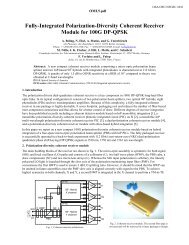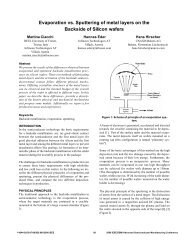Real-Time FPGA-Based Intradyne Coherent Receiver for 40 Gbit/s ...
Real-Time FPGA-Based Intradyne Coherent Receiver for 40 Gbit/s ...
Real-Time FPGA-Based Intradyne Coherent Receiver for 40 Gbit/s ...
Create successful ePaper yourself
Turn your PDF publications into a flip-book with our unique Google optimized e-Paper software.
OTuN4.pdf<br />
<strong>Real</strong>-<strong>Time</strong> <strong>FPGA</strong>-<strong>Based</strong> <strong>Intradyne</strong> <strong>Coherent</strong> <strong>Receiver</strong> <strong>for</strong><br />
<strong>40</strong> <strong>Gbit</strong>/s Polarization-Multiplexed 16-QAM<br />
Timo Pfau 1 , Noriaki Kaneda 1 , Stephen Corteselli 1 , Andreas Leven 2 , Young-Kai Chen 1<br />
1: Bell Laboratories, Alcatel-Lucent, 600-700 Mountain Ave, Murray Hill, NJ 07974, USA<br />
2: Bell Laboratories, Alcatel-Lucent, Lorenzstr. 10, 70435 Stuttgart, Germany<br />
timo.pfau@alcatel-lucent.com<br />
Abstract: <strong>Real</strong>-time detection of a <strong>40</strong> <strong>Gbit</strong>/s polarization-multiplexed square 16-QAM signal is<br />
demonstrated in an <strong>FPGA</strong>-based intradyne coherent receiver processing 100% of data. A<br />
minimum BER of 3.3×10 -5 is achieved.<br />
OCIS codes: (060.1660) <strong>Coherent</strong> communications; (060.4510) Optical communications<br />
1. Introduction<br />
As the per-channel bit rate increases to <strong>40</strong>0 <strong>Gbit</strong>/s and 1 Tbit/s, multilevel modulation <strong>for</strong>mats such as 16-ary<br />
quadrature amplitude modulation (16-QAM) gain increasing attention [1]. But in order to achieve a complete and<br />
precise understanding of the per<strong>for</strong>mance of the required digital signal processing (DSP), it is crucial to evaluate the<br />
corresponding algorithms using real-time prototypes [2]. This is the only way to measure low bit error rates (BER),<br />
to investigate dynamic effects and to capture rare events. In addition the hardware implementation of the receiver<br />
algorithms allows <strong>for</strong> a much more precise evaluation of resource requirements as well as latencies and their impact<br />
on the per<strong>for</strong>mance.<br />
While real-time receiver implementations <strong>for</strong> quadrature phase shift keying (QPSK) and orthogonal frequency<br />
division multiplex (OFDM) have already been studied in detail [3,4], only one real-time implementation of a singlepolarization<br />
DSP-based intradyne coherent receiver <strong>for</strong> 16-QAM has been reported [5]. Other experiments carried<br />
out so far used either offline processing or pilot-based phase noise cancellation techniques [1,6].<br />
In this paper we report the implementation of a real-time <strong>FPGA</strong>-based coherent intradyne receiver <strong>for</strong><br />
polarization-multiplexed 16-QAM transmission. The achieved symbol rate is 5 Gbaud, which corresponds to a data<br />
rate of <strong>40</strong> <strong>Gbit</strong>/s.<br />
2. Polarization-multiplexed 16-QAM transmission system<br />
The setup of the <strong>40</strong> <strong>Gbit</strong>/s 16-QAM transmission system is shown in Fig. 1. Two four-level drive signals are<br />
generated using an arbitrary wave<strong>for</strong>m generator (AWG). The signals are determined using four copies of a binary<br />
pseudo-random bit sequence (PRBS) of length 2 15 -1, which are mutually delayed by 225 bits. Two sequences are<br />
considered as most significant bits (MSBI and MSBQ), are differentially encoded and define the quadrant of the<br />
square 16-QAM constellation. The other two sequences are considered the least significant bits (LSBI and LSBQ)<br />
and are used without further encoding to select the inphase and quadrature amplitude levels within the quadrant.<br />
Equalization is added to the resulting wave<strong>for</strong>m to compensate <strong>for</strong> low-pass effects in the transmitter and <strong>for</strong> the<br />
nonlinear transfer function of the modulator. The eye diagram of the four-level drive signal is shown in Fig. 1.<br />
The two AWG output signals are amplified and applied to a LiNbO3 Mach-Zehnder (I/Q) modulator. As light<br />
source a tunable external cavity laser (ECL) with a power of 12 dBm and specified linewidth of 100 kHz is used.<br />
Fig. 1: Polarization-multiplexed 16-QAM transmission system<br />
OSA/OFC/NFOEC 2011
OTuN4.pdf<br />
The 5 Gbaud 16-QAM optical intensity eye diagram with its three intensity levels corresponding to the three rings<br />
that make up a square 16-QAM constellation is also shown in Fig. 1. Polarization division multiplexing (PDM) is<br />
achieved by splitting the modulator output signal using a polarization beam splitter (PBS), delaying one branch, and<br />
recombining the two branches in a polarization beam combiner (PBC). The intensity eye diagram of the resulting<br />
<strong>40</strong> <strong>Gbit</strong>/s polarization-multiplexed 16-QAM signal is depicted in Fig. 1.<br />
The transmitter output signal is passed through a polarization scrambler, a variable optical attenuator (VOA) and<br />
is amplified in an erbium doped fiber amplifier (EDFA). An additional VOA following the EDFA and a manual<br />
polarization controller are used to control the signal power and state of polarization (SOP) entering the optoelectronic<br />
receiver frontend, respectively. There the signal is combined with a local oscillator (LO) laser in a<br />
polarization diversity 90-degree optical hybrid. The LO is the same type of ECL as used at the transmitter, and is<br />
tuned within approximately ±50 MHz of the received signal’s center frequency. The outputs of the hybrid are<br />
detected in four single-ended photodiodes, which are connected through amplifiers to the analog-to-digital<br />
converters (ADC). The ADCs sample the input signals with 10 Gs/s (T/2-spaced sampling) at a nominal resolution<br />
of 8 bits. Due to the lack of a clock recovery circuit the transmitter clock is used to clock the receiver. The receiver<br />
frontend has a measured 3-dB bandwidth of ~3 Ghz. The two ADCs of each polarization are interfaced with a Xilinx<br />
Virtex 5 field programmable gate array (<strong>FPGA</strong>), in which frontend equalization and IQ correction are per<strong>for</strong>med.<br />
The two <strong>FPGA</strong>s then pass their data to a third identical <strong>FPGA</strong>, in which polarization control, intermediate frequency<br />
(IF) compensation, carrier recovery, data decoding, and bit error counting are implemented. The 3 <strong>FPGA</strong>s are<br />
connected to a personal computer (PC), which calculates the BER and provides a user interface to the receiver.<br />
3. <strong>Real</strong>-time digital signal processing<br />
The <strong>FPGA</strong>s process 100% of the <strong>40</strong> <strong>Gbit</strong>/s data stream and operate with a core clock frequency of 156.25 MHz.<br />
There<strong>for</strong>e 64 parallel channels are required in FGPA-1 and -2 to process the received symbols. The first step in<br />
signal processing is frontend equalization. After removing a possible offset, the data from each ADC is passed<br />
through a real-valued 15 tap finite impulse response (FIR) filter to compensate <strong>for</strong> the low-pass behaviour of the<br />
frontend [7]. Then the signal is fed into an IQ correction block, which compensates imperfections of the 90-degree<br />
hybrid by minimizing the cross-correlation between the real and imaginary part [8]. Then the data from FGPA-1 and<br />
-2 is passed on to <strong>FPGA</strong>-3.<br />
Due to resource limitations <strong>FPGA</strong>-3 cannot operate on the oversampled data. There<strong>for</strong>e <strong>FPGA</strong>-3 downsamples<br />
the data to 1 sample/symbol, which requires only 32 parallel channels. First the two polarizations are separated using<br />
a single tap butterfly filter. The filter coefficients are updated using the standard constant modulus algorithm (CMA)<br />
[8]. Again due to resource limitations only one polarization is processed after polarization control. Which<br />
polarization to process can be switched through the PC user interface. Then the DSP compensates <strong>for</strong> the<br />
constellation rotation caused by the frequency mismatch between signal and LO laser. As the IF varies rather slowly<br />
its estimate can be updated using a feedback algorithm with an integral controller. The differential phase between<br />
subsequent symbols is used as error signal. The carrier phase is recovered in a feed-<strong>for</strong>ward structure, using the<br />
QPSK partitioning algorithm with sliding window averaging and a filter width of 31 symbols [9].<br />
After data recovery and differential decoding of MSBI and MSBQ, all 4 recovered bit streams are fed into bit<br />
error counters. The measurement inside the <strong>FPGA</strong> enables the monitoring of all 4 bit streams in parallel, i.e. all<br />
received bits are considered <strong>for</strong> error counting. The measured bit error numbers are read by the personal computer<br />
(PC), in which the BER is calculated.<br />
Fig. 2: <strong>Coherent</strong> receiver frontend and real-time digital signal processing<br />
OSA/OFC/NFOEC 2011
OTuN4.pdf<br />
4. <strong>Real</strong>-time 16-QAM measurement results<br />
In a first experiment only one polarization is transmitted, the polarization scrambler is switched off, and the SOP<br />
is manually adjusted to be aligned with either the x-polarization or the y-polarization of the receiver. In <strong>FPGA</strong>-3 the<br />
polarization control is bypassed, i.e. only IF compensation and carrier recovery are active. The measurement results<br />
are depicted in Fig. 3. Both polarizations show a very similar per<strong>for</strong>mance and exhibit an error floor at<br />
BERx = 1.6×10 -5 and BERy = 2.1×10 -5 . The required OSNR <strong>for</strong> a BER = 2×10 -3 is 15dB. From the input<br />
constellations (insets in Fig. 3) it can seen that the receiver per<strong>for</strong>mance suffers from common mode noise. This is a<br />
major limitation of the current setup. The replacement of the single-ended by differential photodetectors can resolve<br />
this problem and improve the per<strong>for</strong>mance.<br />
In a second experiment the polarization scrambler is turned on (scan rate 8) and the polarization control in the<br />
<strong>FPGA</strong> is enabled. Fig. 4 shows the results <strong>for</strong> single polarization transmission with static SOP (polarization control<br />
disabled) and scrambled SOP (polarization control active), as well as PDM transmission. The receiver sensitivity <strong>for</strong><br />
single polarization transmission slightly improves by 0.3dB when the polarization control is enabled. This is related<br />
to the fact that the CMA not only separates the polarizations, but also compensates <strong>for</strong> residual amplitude<br />
differences between the real and imaginary part of each polarization. For PDM transmission a small excess penalty<br />
of 0.4dB beyond the 3dB expected penalty is observed. This might be due to residual polarization crosstalk, as no<br />
special 16-QAM adaptation of the CMA was implemented in the receiver.<br />
Fig. 3: BER vs. OSNR <strong>for</strong> single polarization transmission Fig. 4: BER vs. OSNR <strong>for</strong> single polarization and<br />
manually adjusted to x- and y-polarization. PDM transmission with static or scrambled SOP.<br />
4. Summary<br />
We have implemented a 5 Gbaud real-time <strong>FPGA</strong>-based intradyne coherent receiver <strong>for</strong> optical PDM 16-QAM<br />
transmission. At the data rate of <strong>40</strong> <strong>Gbit</strong>/s the minimum BER in back-to-back transmission is 3.3×10 -5 , and the<br />
required OSNR <strong>for</strong> a BER of 2×10 -3 is 18.4 dB.<br />
5. References<br />
[1] A. Gnauck, P. Winzer, “Ultra-High-Spectral-Efficiency Transmission,” Proc. OFC’10, OWE4, March 21-25, 2010, San Diego, CA, USA.<br />
[2] C. Fludger et al., “<strong>Real</strong>-time Prototypes <strong>for</strong> Digital <strong>Coherent</strong> <strong>Receiver</strong>s,” Proc. OFC’10, OMS1, March 21-25, 2010, San Diego, CA, USA.<br />
[3] T. Pfau, R. Peveling, J. Hauden et al, “<strong>Coherent</strong> Digital Polarization Diversity <strong>Receiver</strong> <strong>for</strong> <strong>Real</strong>-<strong>Time</strong> Polarization-Multiplexed QPSK<br />
Transmission at 2.8 <strong>Gbit</strong>/s,” IEEE Photon. Technol. Lett., Vol. 19, No. 24, Dec. 15, 2007, pp. 1988-1990<br />
[4] N. Kaneda, Q. Yang, X. Liu, S. Chandrasekhar, W. Shieh, Y.-K. Chen, “<strong>Real</strong>-<strong>Time</strong> 2.5 GS/s <strong>Coherent</strong> Optical <strong>Receiver</strong> <strong>for</strong> 53.3-Gb/s Sub-<br />
Banded OFDM,” IEEE J. Lightwave Technol., Vol. 28, No. 4, Aug. 27, 2009, pp. 494-501.<br />
[5] A. Al-Bermani, C. Wördehoff, S. Hoffmann, K. Puntsri, T. Pfau, U. Rückert, R. Noé, “<strong>Real</strong>time 16-QAM Transmission with <strong>Coherent</strong> Digital<br />
<strong>Receiver</strong>,” Proc. OECC’10, 7B4-2, July 5-9, 2010, Sapporo, Japan.<br />
[6] M. Nakamura, Y. Kamio, T. Miyazaki, “Linewidth-tolerant 10-<strong>Gbit</strong>/s 16-QAM transmission using a pilot-carrier based phase-noise cancelling<br />
technique,” Opt. Express, Vol. 16, No. 14, July 1, 2008, pp. 10611-10616.<br />
[7] T. Parks, C. Burrus, Digital Filter Design, John Wiley & Sons, Aug. 26, 1987, pp. 54-83.<br />
[8] A. Leven, N. Kaneda, S. Corteselli, “<strong>Real</strong>-<strong>Time</strong> Implementation of Digital Signal Processing <strong>for</strong> <strong>Coherent</strong> Optical Digital Communication<br />
Systems,” IEEE J. Sel. Top. Quantum Electron., Vol. 16, No. 5, May 16, 2010, pp. 1227-1234.<br />
[9] I. Fatadin, D. Ives, S. Savory, “Laser linewidth tolerance <strong>for</strong> 16-QAM coherent optical systems using QPSK partitioning,” IEEE Photon.<br />
Technol. Lett., Vol. 22, No. 9, Feb. 22, 2010, pp. 631–633.<br />
OSA/OFC/NFOEC 2011










